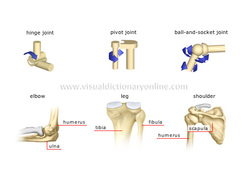
- Pivot joints (known also as rotary joints). These joints allow for rotation around an axis. There is a pivot joint near the top of your spine that allows your head to move from side to side.
- Hinge joints. This type of joint can open and close like a door. Your elbow is a hinge joint. Your biceps and triceps muscle are basically two people standing on opposite sides of a wall (the humerus, or upper-arm bone), each with one hand reaching over to its respective side of a door (the bones of the lower arm). The biceps "shuts" the door, by contracting and lessening the degree of the joint angle, and the triceps, when it pulls on its respective side of the door, "opens" the door, as the hinge then widens.
- Gliding joints (known also as plane joints). This type of joint features two bone plates that glide against one another. The joints in your ankles and wrists are gliding joints. (Holding your forearm steady while your hand points upward and then waving side-to-side with your hand is an example of this joint's functioning.)
- Ball-and-socket joints. This is the most maneuverable type of joint. Your shoulder and your hip are both ball-and-socket joints. These joints feature a connection between one bone-end equipped with a protrusion that fits into the receptive space at the end of the other bone in the joint. These joints allow for forward motion, backward motion and circular rotation.
- Saddle joints. These joints allow for two different types of movement. For instance, a saddle joint allows your thumb to move toward and away from your forefinger (as when you spread all five digits out, then bring them all together side-by-side) as well as cross over the palm of your hand toward your little finger.
- Conyloid joints. These joints are similar to ball-and-socket joints, just without the socket (the "ball" simply rests against another bone end).
Aidan Raftery
Sports Therapist
11/3/2014
 RSS Feed
RSS Feed
